| |
PALEOMAGNETISM
Remanent magnetism of rock strata adjacent to the K-T interface in the San Juan Basin provides an objective geochronologic tool for placement of the K-T interface and for estimating a more precise age for the base of the Ojo Alamo Sandstone. Paleomagnetic studies of these rocks have been conducted by different workers in the southern San Juan Basin at nine localities (Figure 1,
Figure 3). This report presents published paleomagnetic data from eight localities and one previously unpublished paleomagnetic data set from the Mesa Portales study area (Figure 1,
Figure 3) in an integrated format. Eight of the published paleomagnetic studies were in:
Butler et al. (1977);
Lindsay et al. (1978,
1981,
1982);
Butler and Lindsay (1985); and
Fassett and Steiner (1997). The paleomagnetic data presented herein demonstrate that the dinosaur-bearing part of the Ojo Alamo Sandstone in the southern San Juan Basin is within the lower part of normal-polarity chron C29n and is thus Paleocene in age.
 Four of the paleomagnetic sections through the Ojo Alamo Sandstone were discussed in
Lindsay et al. (1981): South Mesa, Barnum Brown Amphitheater, Barrel Spring, and Betonnie Tsosie Wash (Figure 3 and
Figure 4). The South Mesa, Barnum Brown Amphitheater, and Barrel Spring sections are 1.3 km and 1.8 km apart, respectively, (Figure 4) and are in the heart of what is known as the Ojo Alamo Sandstone type area (Bauer 1916,
Baltz et al. 1966,
Fassett 1973,
Fassett 2000,
Fassett et al. 2002). These three sections are also within the Bisti - De-na-zin Wilderness Area on the south edge of a topographic feature named "South Mesa" by
Clemens (1973b, figure 3); South Mesa is capped by the Ojo Alamo Sandstone. Clemens defined South Mesa as being outlined by the 6,400ft contour line on the USGS 1:24,000 Alamo
Mesa East Topographic Quadrangle (the name "South Mesa" does not appear on that map). The Betonnie Tsosie Wash section is about 27 km southeast of the Ojo Alamo type area (Figure 3). Four of the paleomagnetic sections through the Ojo Alamo Sandstone were discussed in
Lindsay et al. (1981): South Mesa, Barnum Brown Amphitheater, Barrel Spring, and Betonnie Tsosie Wash (Figure 3 and
Figure 4). The South Mesa, Barnum Brown Amphitheater, and Barrel Spring sections are 1.3 km and 1.8 km apart, respectively, (Figure 4) and are in the heart of what is known as the Ojo Alamo Sandstone type area (Bauer 1916,
Baltz et al. 1966,
Fassett 1973,
Fassett 2000,
Fassett et al. 2002). These three sections are also within the Bisti - De-na-zin Wilderness Area on the south edge of a topographic feature named "South Mesa" by
Clemens (1973b, figure 3); South Mesa is capped by the Ojo Alamo Sandstone. Clemens defined South Mesa as being outlined by the 6,400ft contour line on the USGS 1:24,000 Alamo
Mesa East Topographic Quadrangle (the name "South Mesa" does not appear on that map). The Betonnie Tsosie Wash section is about 27 km southeast of the Ojo Alamo type area (Figure 3).
The South Mesa paleomagnetic section through the Ojo Alamo Sandstone is the upper part of a longer section labeled the Hunter Wash-Alamo Wash section in
Lindsay et al. (1981). In a later report by
Butler and Lindsay (1985), the part of this paleomagnetic section through the Ojo Alamo Sandstone was named the South Mesa section. The Betonnie Tsosie Wash section (Figure 3) was named the "Tsosie Wash" section in
Lindsay et al. (1981). however, the wash this section is named for is Betonnie Tsosie Wash (USGS 1:24,000 Kimbeto Topographic Quadrangle). The Moncisco Mesa and Eagle Mesa sections do not include the Ojo Alamo Sandstone and were published in
Butler and Lindsay (1985). The Hunter Wash section (Fassett and Steiner 1997) includes all of the Kirtland Formation and the lower part of the Ojo Alamo Sandstone in the western part of the type area (Figure 4).
Rock samples for the Mesa Portales paleomagnetic section were collected in 1983 by E.M. Shoemaker (USGS, deceased), M.B. Steiner (U. of Wyoming), and the author and in 1989 by Steiner and the author. Paleomagnetic analyses of these samples were performed by Steiner at the University of Wyoming and by J.L. Kirschvink (for Shoemaker) at the California Institute of Technology. The Mesa Portales section is especially important because it is supplemented by detailed palynologic data from multiple stratigraphic levels through the Upper Cretaceous Fruitland-Kirtland Formation (undivided), across the Cretaceous-Tertiary interface, and upward through most of the Paleocene Ojo Alamo Sandstone. Some of the Mesa Portales palynologic data were published in
Fassett and Hinds (1971); additional palynologic data from that locality are presented herein for the first time. An earlier palynologic study of the Ojo Alamo Sandstone about 15 km northeast of Mesa Portales (Figure 3) was published by
Anderson (1960) and the significance of Anderson's data, as related to the Paleocene age of the Ojo Alamo Sandstone, is discussed in the
"Palynology" section of this report.
Because magnetochrons contain no inherent geochronologic information, it is essential that paleomagnetic data be supported by other geochronologic data to uniquely identify them. For Cretaceous rocks underlying the Ojo Alamo Sandstone, a robust sequence of eight precise 40Ar/39Ar radiometric ages exists (Fassett and Steiner 1997,
Fassett 2000,
Fassett et al. 2002), thus the two magnetochrons identified in the southern San Juan Basin in these strata are unquestionably chrons C33n and C32r. Moreover, the stratigraphically highest radiometric date: 73.04 ± 0.25 Ma, for an altered volcanic ash bed (ash J,
Figure 4) less than 5 m below the base of the Ojo Alamo Sandstone near Hunter Wash, confirmed the presence of a 7.8-m.y. hiatus separating the Kirtland Formation of Cretaceous (Campanian) age from the overlying Ojo Alamo Sandstone of Paleocene age. Palynomorphs identified from these strata also help to date them, although somewhat less precisely.
Tschudy (1973) and
Newman (1987) published palynologic data from the stratigraphically highest Cretaceous rocks in the San Juan Basin. Both of these studies indicated that a significant hiatus existed at the K-T interface representing all or most of Maastrichtian time; the radiometric dates published by
Fassett and Steiner (1997) and
Fassett (2000) confirmed the biochronologic findings of Tschudy and Newman.
All attempts to radiometrically date the Ojo Alamo Sandstone have thus far been unsuccessful; however, all paleobotanical evidence suggests a Paleocene age (Reeside 1924,
Knowlton 1924,
Anderson 1960,
Fassett and Hinds 1971,
Tschudy 1973,
Fassett 1982,
Fassett 1987,
Fassett and Steiner 1997,
Fassett 2000,
Fassett and Lucas 2000, and
Fassett et al. 2002). New, robust palynologic data from the Mesa Portales locality confirm these earlier studies
that showed that the age of the entire formation is Paleocene; a summary of this palynologic
data is contained in the "Palynology" section of this report.
Puercan-age (lowermost Paleocene) vertebrate fossils have been identified in the lowermost part of the Nacimiento Formation. The Nacimiento directly overlies and intertongues with the Ojo Alamo Sandstone at five localities in the southern San Juan Basin. These data provide additional, if inferential, evidence that at least the upper part of the Ojo Alamo is Paleocene (Williamson and Lucas 1992,
1993;
Williamson 1996). Vertebrate paleontologists have disagreed about the biochronologic age of the lower, dinosaur-bearing part of the Ojo Alamo Sandstone. For example,
Sullivan,
Lucas, and Braman (2005) contended that the Ojo Alamo contains a dinosaur fauna that is latest Campanian or early Maastrichtian whereas
Weil and Williamson (2000) and
Farke and Williamson (2006) state that the vertebrate fauna of the lower Ojo Alamo is clearly Lancian (latest Maastrichtian) in age. These different vertebrate-fossil ages for the Ojo Alamo are evaluated in the "Vertebrate Paleontology" section of this paper.
The following sections discuss the several published paleomagnetic studies that include the Ojo Alamo Sandstone. These publications are presented in chronologic order to best show the evolution of thinking about the numbering of the magnetic-polarity intervals identified in the rock strata adjacent to the K-T interface in the southern San Juan Basin. In this historical discussion, the relatively thin, normal-magnetic-polarity interval within the Ojo Alamo Sandstone is labeled C29n, after
Lindsay et al. (1981),
Fassett and Steiner (1997), and
Fassett (2000). This thin Ojo Alamo-normal interval is now known to be only the lowermost part of chron C29n and is therefore designated C29n.2n as discussed in the "Identification of Magnetochrons" section of this paper.
Barrel Spring Arroyo. The Barrel Spring Arroyo paleomagnetic section
(BSA,
Figure 4) is on the north side of De-na-zin arroyo, about 0.4 km north of Barrel Spring. The paleomagnetic data plot for this section of
Lindsay et al. (1981, figure 7) is shown on
Figure 5. This plot contains five data points of reversed polarity in the Kirtland Formation, four data points with normal polarity in the lower part of the Ojo Alamo Sandstone, and five data points with reversed polarity in the upper part of the Ojo Alamo. Additional alternating zones of normal and reversed polarity are shown in the overlying Nacimiento Formation. The entire section is about 160 m in length, and critical data points below, within, and above the Ojo Alamo Sandstone are numbered in meters, below or above the base of the Ojo Alamo Sandstone. The magnetochrons in the lower part of the section were labeled B-, C+, D-, E+, F-, and G+ by Lindsay et al. (1981) on their figure 7, but in a subsequent section of their paper were relabeled C29r, C29n, C28r, C28n, C27r, and C27n, respectively, as shown on
Figure 5.
Figure 6 is an annotated photograph of the Barrel-Spring-Arroyo locality showing that the Ojo Alamo Sandstone consists of a lower conglomeratic sandstone, a middle "shaly" part, and an upper, massive, conglomeratic-sandstone bench. The stratigraphic positions of the paleomagnetic data points from
Lindsay et al. (1981) were placed on this photograph based on the locations of these points shown on
Figure 5.
Figure 5 and
Figure 6 show that the Ojo Alamo at this
locality contains in its lower part a normal magnetochron (labeled C29n by
Lindsay et al. 1981). This normal interval is shown to be about 14 m thick, based on the assumption that a thin, reversed-polarity interval, the uppermost part of chron C29r, is present here in the lowermost part of the Ojo Alamo Sandstone. This assumption is based on the fact that all other paleomagnetic sections through the Ojo Alamo Sandstone in the southern San Juan Basin show the presence of a thin reversed paleomagnetic interval in the lowermost part of this formation. All but one of the samples collected for paleomagnetic analyses were from gray mudstones; the sample at 9.0 m above the base of the Ojo Alamo (Figure 6) is from a slightly reddish-brown mudstone. The lower samples are from a gently sloping topographic bench, whereas samples 13.5, 15.2, and 16.2 are from more steeply dipping terrain. Note on
Figure 6 that all samples were collected from mudstone layers avoiding the prominent white sandstone beds present in the middle "shaly" part of the Ojo Alamo. The lensing nature of all of the strata in the middle part of the Ojo Alamo is apparent at this locality. an annotated photograph of the Barrel-Spring-Arroyo locality showing that the Ojo Alamo Sandstone consists of a lower conglomeratic sandstone, a middle "shaly" part, and an upper, massive, conglomeratic-sandstone bench. The stratigraphic positions of the paleomagnetic data points from
Lindsay et al. (1981) were placed on this photograph based on the locations of these points shown on
Figure 5.
Figure 5 and
Figure 6 show that the Ojo Alamo at this
locality contains in its lower part a normal magnetochron (labeled C29n by
Lindsay et al. 1981). This normal interval is shown to be about 14 m thick, based on the assumption that a thin, reversed-polarity interval, the uppermost part of chron C29r, is present here in the lowermost part of the Ojo Alamo Sandstone. This assumption is based on the fact that all other paleomagnetic sections through the Ojo Alamo Sandstone in the southern San Juan Basin show the presence of a thin reversed paleomagnetic interval in the lowermost part of this formation. All but one of the samples collected for paleomagnetic analyses were from gray mudstones; the sample at 9.0 m above the base of the Ojo Alamo (Figure 6) is from a slightly reddish-brown mudstone. The lower samples are from a gently sloping topographic bench, whereas samples 13.5, 15.2, and 16.2 are from more steeply dipping terrain. Note on
Figure 6 that all samples were collected from mudstone layers avoiding the prominent white sandstone beds present in the middle "shaly" part of the Ojo Alamo. The lensing nature of all of the strata in the middle part of the Ojo Alamo is apparent at this locality.
Barnum Brown Amphitheater. The Barnum Brown Amphitheater paleomagnetic section (BBA,
Figure 4) is on the south edge of South Mesa; this locality is about 1.8 km west of the Barrel Spring Arroyo (BSA) section. (The name "Barnum Brown Amphitheater" was apparently coined by
Lindsay et al. (1981) for this locality and should not be confused with the amphitheater referred to by
Barnum Brown (1910) that is several kilometers northeast of this locality in Alamo Wash stratigraphically above the Ojo Alamo Sandstone in the Nacimiento Formation.) The paleomagnetic section at the BBA locality is short (~32 m), consisting of only 11 sample levels; samples were collected from the uppermost Kirtland Formation and the lower part of the Ojo Alamo Sandstone (Figure 5). The five Kirtland samples exhibit reversed polarity; the lowest Ojo Alamo sample also exhibits reversed polarity, the next three samples in the lower Ojo Alamo exhibit normal-reversed-normal polarity, and the uppermost three samples show reversed polarity.
Lindsay et al. (1981, p. 411) stated that the reversed site in the middle of the Ojo Alamo Sandstone normal interval at the Barnum Brown locality was weakly magnetized and that ". . . the site mean VGP moved toward positive values during AF demagnetization. Thus we do not interpret the data from this site to be a reliable indication of a reversed subzone within normal C+ [C29n]."
Figure 7 is an annotated photograph showing that the Ojo Alamo Sandstone at the BBA locality consists of a lower conglomerate, a middle "shaly" unit, and an upper more massive sandstone bench. The lithologies of the Ojo Alamo Sandstone at the BBA and BSA localities are similar, except there is more sandstone present at the BBA locality in the middle part of the Ojo Alamo. The stratigraphic locations of the paleomagnetic data points from the
Lindsay et al. (1981) report are placed on this photograph based on the positions of these points shown on
Figure 5. The normal-polarity interval labeled C29n by these authors is 11 m thick at the BBA locality; the underlying interval of reversed polarity in the lowermost Ojo Alamo—labeled C29r—is 2.6 m thick. All of the samples collected at this locality were from gray mudstones. The lowermost, reversed-polarity sample (2.5) was from a gently sloping hill, whereas the higher Ojo Alamo samples were from a much steeper cliff face. an annotated photograph showing that the Ojo Alamo Sandstone at the BBA locality consists of a lower conglomerate, a middle "shaly" unit, and an upper more massive sandstone bench. The lithologies of the Ojo Alamo Sandstone at the BBA and BSA localities are similar, except there is more sandstone present at the BBA locality in the middle part of the Ojo Alamo. The stratigraphic locations of the paleomagnetic data points from the
Lindsay et al. (1981) report are placed on this photograph based on the positions of these points shown on
Figure 5. The normal-polarity interval labeled C29n by these authors is 11 m thick at the BBA locality; the underlying interval of reversed polarity in the lowermost Ojo Alamo—labeled C29r—is 2.6 m thick. All of the samples collected at this locality were from gray mudstones. The lowermost, reversed-polarity sample (2.5) was from a gently sloping hill, whereas the higher Ojo Alamo samples were from a much steeper cliff face.
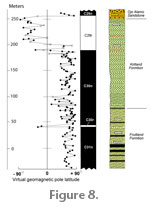 This steeper cliff face reflects the topographic expression of the white sandstone beds in the upper part of the middle interval of the Ojo Alamo Sandstone.
Figure 7 shows that the samples collected for paleomagnetic analyses at this locality were from relatively thin interbeds of mudstone. This steeper cliff face reflects the topographic expression of the white sandstone beds in the upper part of the middle interval of the Ojo Alamo Sandstone.
Figure 7 shows that the samples collected for paleomagnetic analyses at this locality were from relatively thin interbeds of mudstone.
South Mesa. The South Mesa (SM) paleomagnetic section is at the west end of South Mesa near a westward-projecting spur capped by the cliff-forming Ojo Alamo Sandstone (Figure 4). This section is the uppermost part of a much longer paleomagnetic section through the underlying Fruitland and Kirtland Formations.
Lindsay et al. (1981) named this the Hunter Wash/Alamo Wash section (Figure 8).
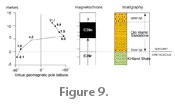 Figure 9, a large-scale paleomagnetic plot through the uppermost Kirtland Formation and lower part of the Ojo Alamo Sandstone, contains three reversed-polarity and four normal-polarity data points. The numbers shown for each data point are distances in meters above or below the base of the Ojo Alamo Sandstone. This paleomagnetic section ended just beneath the base of the upper massive sandstone bed of the Ojo Alamo, thus the top of magnetochron C29n was not located at this locality. Magnetochrons C29n and C29r are shown on
Figure 9 as identified by
Lindsay et al. (1981). Figure 9, a large-scale paleomagnetic plot through the uppermost Kirtland Formation and lower part of the Ojo Alamo Sandstone, contains three reversed-polarity and four normal-polarity data points. The numbers shown for each data point are distances in meters above or below the base of the Ojo Alamo Sandstone. This paleomagnetic section ended just beneath the base of the upper massive sandstone bed of the Ojo Alamo, thus the top of magnetochron C29n was not located at this locality. Magnetochrons C29n and C29r are shown on
Figure 9 as identified by
Lindsay et al. (1981).
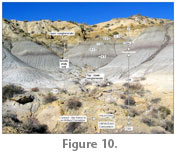 Figure 10 is an annotated photograph of the South Mesa paleomagnetic locality, and here, as at the Barrel Spring and Barnum Brown Amphitheater localities, the Ojo Alamo Sandstone consists of a lower conglomerate bed, a middle "shaly" unit, and an upper, massive, conglomeratic sandstone bench. The stratigraphic locations of the paleomagnetic data points from
Lindsay et al. (1981) are placed on this photograph based on the positions of these points shown on
Figure 8 and
Figure 9. Magnetic normal interval C29n is 5.9 m thick here (top not determined), and the underlying reversed-polarity chron C29r (in the lowermost part of the Ojo Alamo) is 5 m thick. All samples collected for paleomagnetic analysis at this locality appear to have come from gray mudstones. The reversed-polarity sample 1 m above the base of the Ojo Alamo in the basal part of the middle "shaly" unit is from a gently sloping topographic bench. Reversed polarity sample 4.5 and the four overlying samples of normal polarity, were from a much steeper cliff face. The middle "shaly" interval of the Ojo Alamo Sandstone contains multiple sandstone beds at this locality. Figure 10 is an annotated photograph of the South Mesa paleomagnetic locality, and here, as at the Barrel Spring and Barnum Brown Amphitheater localities, the Ojo Alamo Sandstone consists of a lower conglomerate bed, a middle "shaly" unit, and an upper, massive, conglomeratic sandstone bench. The stratigraphic locations of the paleomagnetic data points from
Lindsay et al. (1981) are placed on this photograph based on the positions of these points shown on
Figure 8 and
Figure 9. Magnetic normal interval C29n is 5.9 m thick here (top not determined), and the underlying reversed-polarity chron C29r (in the lowermost part of the Ojo Alamo) is 5 m thick. All samples collected for paleomagnetic analysis at this locality appear to have come from gray mudstones. The reversed-polarity sample 1 m above the base of the Ojo Alamo in the basal part of the middle "shaly" unit is from a gently sloping topographic bench. Reversed polarity sample 4.5 and the four overlying samples of normal polarity, were from a much steeper cliff face. The middle "shaly" interval of the Ojo Alamo Sandstone contains multiple sandstone beds at this locality.
 Betonnie Tsosie Wash. The Betonnie Tsosie Wash (BTW) paleomagnetic section ("Tsosie Wash" section of
Lindsay et al. 1981) is about 28 km southeast of the Ojo Alamo Sandstone type area (Figure 3). This locality is on an outlier of middle and upper Ojo Alamo Sandstone strata on the east side of a north-trending tributary of Betonnie Tsosie Wash (Figure 11). The paleomagnetic data plot for samples collected from this locality (Figure 12) contains five normal-polarity sites at the base overlain by two reversed-polarity sites in the middle Ojo Alamo Sandstone; one normal-polarity sample is in the upper part of the Ojo Alamo. Betonnie Tsosie Wash. The Betonnie Tsosie Wash (BTW) paleomagnetic section ("Tsosie Wash" section of
Lindsay et al. 1981) is about 28 km southeast of the Ojo Alamo Sandstone type area (Figure 3). This locality is on an outlier of middle and upper Ojo Alamo Sandstone strata on the east side of a north-trending tributary of Betonnie Tsosie Wash (Figure 11). The paleomagnetic data plot for samples collected from this locality (Figure 12) contains five normal-polarity sites at the base overlain by two reversed-polarity sites in the middle Ojo Alamo Sandstone; one normal-polarity sample is in the upper part of the Ojo Alamo.
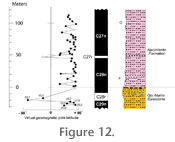 The overlying Nacimiento Formation contains a large number of data points with normal polarity (and one sample with reversed polarity). The middle and upper parts of the Ojo Alamo Sandstone at this locality are about 27 m thick. The base of the Ojo Alamo is about 5 m stratigraphically below the 26.6 sample locality (Figure 12). This paleomagnetic section is particularly important because it includes a Puercan mammal quarry only 12 m above the top of the Ojo
Alamo (Figure 11 and
Figure 12). (The biochronology of the paleomagnetic sections included in this report is discussed in detail in subsequent sections of this paper.) The magnetochron labeled C29n (Figure 12) is 7.1 m thick, however, its base was not determined because of alluvial cover immediately below sample 26.6. Chron C29n is overlain by chrons labeled C28r, C28n, C27r, and C27n by
Lindsay et al. (1981). (These labels are revised in a subsequent section of this paper.) The overlying Nacimiento Formation contains a large number of data points with normal polarity (and one sample with reversed polarity). The middle and upper parts of the Ojo Alamo Sandstone at this locality are about 27 m thick. The base of the Ojo Alamo is about 5 m stratigraphically below the 26.6 sample locality (Figure 12). This paleomagnetic section is particularly important because it includes a Puercan mammal quarry only 12 m above the top of the Ojo
Alamo (Figure 11 and
Figure 12). (The biochronology of the paleomagnetic sections included in this report is discussed in detail in subsequent sections of this paper.) The magnetochron labeled C29n (Figure 12) is 7.1 m thick, however, its base was not determined because of alluvial cover immediately below sample 26.6. Chron C29n is overlain by chrons labeled C28r, C28n, C27r, and C27n by
Lindsay et al. (1981). (These labels are revised in a subsequent section of this paper.)
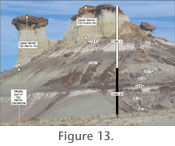 Figure 13 is a photograph of the small butte where samples from the Ojo Alamo Sandstone part of the Betonnie Tsosie Wash paleomagnetic section were collected (Figure 12). This butte is capped by a 4 m thick, hard, iron-cemented, cliff-forming, conglomeratic sandstone layer that is the uppermost part of the upper bench of the Ojo Alamo. The underlying shaly interval is about 11 m thick here with its base masked by alluvium. (A lower sandstone bench of the Ojo Alamo Sandstone is exposed farther south in this tributary of Betonnie Tsosie Wash (Figure 11) and its base is about 5 m below the exposed part of the Ojo Alamo seen on
Figure 13.) The upper part of magnetochron C29n is in the lower part of the middle shaly unit of the Ojo Alamo Sandstone (Figure 13). Most of the paleomagnetic samples were collected from gray mudstone beds; sample 23.6, however, was from maroon-colored strata. All of the sample sites are on a relatively steep topographic slope (Figure 13). Figure 13 is a photograph of the small butte where samples from the Ojo Alamo Sandstone part of the Betonnie Tsosie Wash paleomagnetic section were collected (Figure 12). This butte is capped by a 4 m thick, hard, iron-cemented, cliff-forming, conglomeratic sandstone layer that is the uppermost part of the upper bench of the Ojo Alamo. The underlying shaly interval is about 11 m thick here with its base masked by alluvium. (A lower sandstone bench of the Ojo Alamo Sandstone is exposed farther south in this tributary of Betonnie Tsosie Wash (Figure 11) and its base is about 5 m below the exposed part of the Ojo Alamo seen on
Figure 13.) The upper part of magnetochron C29n is in the lower part of the middle shaly unit of the Ojo Alamo Sandstone (Figure 13). Most of the paleomagnetic samples were collected from gray mudstone beds; sample 23.6, however, was from maroon-colored strata. All of the sample sites are on a relatively steep topographic slope (Figure 13).
Summary. As a result of their paleomagnetic and biochronologic studies of the rock strata adjacent to the Cretaceous-Tertiary (K-T) interface in the southern San Juan Basin,
Lindsay et al. (1981) concluded that there was continuous deposition across it. They identified magnetochrons C31n, C30r, C30n, and the lower part of C29r in the Cretaceous Kirtland Formation beneath the K-T interface and found the upper part of C29r, C29n, C28r, and the lower part of C28n to be within the Ojo Alamo Sandstone, above the K-T interface. In addition, they identified chrons C27n, and C27r higher in the Nacimiento Formation.
Lindsay et al. (1981) thus determined that chron C29n was present in the lower part of the Ojo Alamo Sandstone at all four localities where they had conducted paleomagnetic traverses through that formation.
Lindsay et al. (1982) reexamined their identification of magnetochron C29n in the Ojo Alamo Sandstone because they were apparently troubled by the fact that their data indicated (p. 449) "that the extinction of dinosaurs was not coincident with the extinction of marine organisms at the end of the Cretaceous Period, as recorded in several marine sequences." They were also responding to numerous challenges to their earlier findings by
Alvarez and Vann (1979),
Fassett (1979), and
Lucas and Rigby (1979). Those criticisms primarily related to their conclusion that there had been continuous deposition across the K-T interface in contravention to numerous previous publications indicating that a substantial hiatus existed at this boundary. (Several papers in
Fassett and Rigby 1987 subsequently presented evidence for a substantial hiatus at the K-T interface in the San Juan Basin.)
]=
were also criticized for stating that the K-T boundary in the San Juan Basin was not synchronous with the K-T boundary in the marine sequence near Gubbio, Italy. In their 1982 paper these authors reaffirmed their correlation of the normal-polarity interval in the lower part of the Ojo Alamo Sandstone with magnetochron C29n and concluded (p. 451): "We believe that correlation is accurate, which implies Paleocene dinosaurs lived in the San Juan Basin [my emphasis]." They also reaffirmed their earlier contention that there was no significant hiatus at the K-T interface in the San Juan Basin.
In addition,
Lindsay et al. (1982) stated: "We doubt that magnetochron + [C29n] is caused by a normal overprint . . ." and discussed tests of the reliability of their identification of the lower Ojo Alamo Sandstone normal chron, C29n. They stated that each of their sites that yielded normal remanent magnetic polarity in the Ojo Alamo Sandstone was represented by multiple samples, and that a statistical "test for nonrandom distribution" of their data showed that 87% passed this "rigorous test." In a discussion of the minerals carrying the remanent magnetism in the Kirtland Formation and Ojo Alamo Sandstone in their study localities, they concluded that "the dominant ferromagnetic mineral in sediments of the San Juan Basin is detrital stoichiometric titanomagnetite in the 0.51 x 0.54 proportionality range." They further determined that the Ojo Alamo Sandstone samples did contain a relatively high hematite content but that this higher hematite content existed in both normal and reversed polarity intervals in the Ojo Alamo and stated that "The available data do not favor an overprint origin for magnetozone + [C29n]." They concluded: "Thus, the available data suggest that magnetozone + [C29n] in the San Juan Basin is reliable, and we continue to correlate it with magnetic anomaly 29."
Butler and Lindsay (1985) published the results of further tests of possible overprinting of the normal-polarity interval in the lower part of the Ojo Alamo Sandstone. However, they stated (in some parts of this paper) that the normal interval C29n (labeled + in their report) was in the Kirtland Formation rather than in the Ojo Alamo Sandstone, contrary to the placement of this magnetochron in the Ojo Alamo Sandstone in all of their previous publications. Normal chron C29n (also designated "C+") is clearly shown to be within the Ojo Alamo in their 1981 paper.
Butler and Lindsay (1985) offered no explanation as to why they considered chron C29n to be in the Kirtland Formation in this report. Adding to the confusion, they show this normal to be in the Ojo Alamo in figure 7 of their 1985 paper, even though they state in their figure 7 caption that this figure shows: "Paleomagnetic data from re-collections of the three sections below [my emphasis] Ojo Alamo Sandstone on South Mesa originally used by Lindsay et al. (1981) to define Magnetozone + [C29n]." Because of these conflicting statements, it is not possible to assess with certainty where in the measured sections the "re-collections" discussed by these authors were made.
The 1985 paper by Butler and Lindsay contains a comprehensive discussion of the magnetic minerals that carry the normal-polarity signal in the Ojo Alamo Sandstone at the South Mesa, Barnum Brown Amphitheater, and Barrel Spring Arroyo sections (Figure 4). (Curiously, there is no mention in this paper of the normal-polarity interval identified in 1981 as C29n in the Ojo Alamo at their "Tsosie Wash" locality.) These authors concluded that their previous publications showing the presence of the normal-polarity interval C29n in the lower Ojo Alamo were in error, and stated that this normal interval was in reality a Bruhnes (present-day-normal) overprint, and thus should be removed from their San Juan Basin paleomagnetic section. As a consequence of the elimination of C29n, these authors were forced to re-number the several other magnetochrons they had previously identified overlying it, by changing the next-highest normal from C28n to C29n, changing C27n to C28n, etc.
Butler and Lindsay (1985) concluded that the dinosaur fossils in the Ojo Alamo Sandstone were Cretaceous in age, and they continued to maintain that there was no significant hiatus at the Cretaceous-Tertiary boundary in the San Juan Basin. The question of the validity of the remanent paleomagnetism of the normal interval in the lower Ojo Alamo Sandstone is further addressed in a subsequent section of this paper.
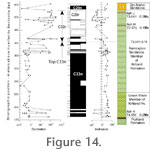 The Hunter Wash paleomagnetic section of
Fassett and Steiner (1997) is in the southwestern part of the San Juan Basin in Hunter Wash and in the headwaters of a northwest-trending tributary of Hunter Wash (Figure 2,
Figure 4). The paleomagnetic data plot for the Hunter Wash section is on
Figure 14. The upper part of this section through the uppermost Kirtland Formation and lower part of the Ojo Alamo Sandstone is shown at an expanded scale on
Figure 15. The Hunter Wash paleomagnetic section of
Fassett and Steiner (1997) is in the southwestern part of the San Juan Basin in Hunter Wash and in the headwaters of a northwest-trending tributary of Hunter Wash (Figure 2,
Figure 4). The paleomagnetic data plot for the Hunter Wash section is on
Figure 14. The upper part of this section through the uppermost Kirtland Formation and lower part of the Ojo Alamo Sandstone is shown at an expanded scale on
Figure 15. This figure shows reversed remanent magnetism 4 m below the base of the Ojo Alamo in the Upper Cretaceous Kirtland Formation, a reversed polarity site 0.8 m above the base of the Paleocene Ojo Alamo Sandstone, two normal-polarity sites higher in the Ojo Alamo, and a reversed site 14.2 m above the base of the Ojo Alamo. Thus, the normal-polarity interval (lower part of C29n) is 7.1 m thick here and is bracketed by reversed-polarity intervals within the Ojo Alamo. The Ojo Alamo Sandstone is mostly sandstone at this locality without the distinct lower conglomerate and middle "shaly" parts found at the South Mesa, Barnum Brown Amphitheater, and Barrel Spring Arroyo localities. This figure shows reversed remanent magnetism 4 m below the base of the Ojo Alamo in the Upper Cretaceous Kirtland Formation, a reversed polarity site 0.8 m above the base of the Paleocene Ojo Alamo Sandstone, two normal-polarity sites higher in the Ojo Alamo, and a reversed site 14.2 m above the base of the Ojo Alamo. Thus, the normal-polarity interval (lower part of C29n) is 7.1 m thick here and is bracketed by reversed-polarity intervals within the Ojo Alamo. The Ojo Alamo Sandstone is mostly sandstone at this locality without the distinct lower conglomerate and middle "shaly" parts found at the South Mesa, Barnum Brown Amphitheater, and Barrel Spring Arroyo localities.
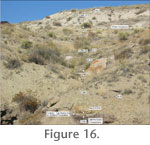 Figure 16 is a photograph of the Ojo Alamo Sandstone outcrop at the Hunter Wash locality. The sandier nature of the lower part of the Ojo Alamo is readily apparent in this photograph. Relatively few rock samples suitable for paleomagnetic analysis could be obtained in the Ojo Alamo at this locality because of the paucity of fine-grained mudstone layers here. The stratigraphic levels of paleomagnetic sample sites on
Figure 15 are shown on this photograph. All of the samples collected here were from thin, gray, mudstone beds on relatively gentle slopes. One of the Ojo Alamo Sandstone dinosaur bones collected for chemical analysis (specimen 022899-OA1, discussed in a subsequent section of this report) was found about 30 m east of the area shown on
Figure 4 and 7.3 m above the base of the Ojo Alamo Sandstone. This bone is within magnetochron C29n. Figure 16 is a photograph of the Ojo Alamo Sandstone outcrop at the Hunter Wash locality. The sandier nature of the lower part of the Ojo Alamo is readily apparent in this photograph. Relatively few rock samples suitable for paleomagnetic analysis could be obtained in the Ojo Alamo at this locality because of the paucity of fine-grained mudstone layers here. The stratigraphic levels of paleomagnetic sample sites on
Figure 15 are shown on this photograph. All of the samples collected here were from thin, gray, mudstone beds on relatively gentle slopes. One of the Ojo Alamo Sandstone dinosaur bones collected for chemical analysis (specimen 022899-OA1, discussed in a subsequent section of this report) was found about 30 m east of the area shown on
Figure 4 and 7.3 m above the base of the Ojo Alamo Sandstone. This bone is within magnetochron C29n.
Identification of Kirtland Formation-Ojo Alamo Sandstone Magnetochrons
Figure 17 is a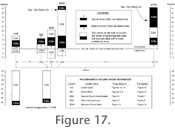 nearly 40 km long stratigraphic cross section from Hunter Wash to Betonnie Tsosie Wash through the Upper Cretaceous Kirtland Formation and Paleocene Ojo Alamo Sandstone in the southwestern part of the San Juan Basin. This cross section illustrates the relations of the five paleomagnetic sections discussed above. Reversal boundaries are placed at the midpoint between the nearest-to-the-reversal-boundary data points. The remarkable thing about this cross section is that it shows that every published paleomagnetic section through the Ojo Alamo Sandstone in the southern San Juan Basin reveals the presence of a normal-polarity interval in the lower part of the Ojo Alamo. At two of the localities: HW and BBA, this normal interval is bracketed within the Ojo Alamo by reversed-polarity intervals. At two other localities: SM and BTW, either the top or base of the normal interval was not determined. And at one locality: BSA, the base of this normal is not bracketed within the Ojo Alamo. nearly 40 km long stratigraphic cross section from Hunter Wash to Betonnie Tsosie Wash through the Upper Cretaceous Kirtland Formation and Paleocene Ojo Alamo Sandstone in the southwestern part of the San Juan Basin. This cross section illustrates the relations of the five paleomagnetic sections discussed above. Reversal boundaries are placed at the midpoint between the nearest-to-the-reversal-boundary data points. The remarkable thing about this cross section is that it shows that every published paleomagnetic section through the Ojo Alamo Sandstone in the southern San Juan Basin reveals the presence of a normal-polarity interval in the lower part of the Ojo Alamo. At two of the localities: HW and BBA, this normal interval is bracketed within the Ojo Alamo by reversed-polarity intervals. At two other localities: SM and BTW, either the top or base of the normal interval was not determined. And at one locality: BSA, the base of this normal is not bracketed within the Ojo Alamo.
The number of paleomagnetic sample sites defining this normal interval varies from two to five. The average thickness of the normal interval, as shown, is 9.1 m; the average thickness at the localities where the normal's top and bottom were determined is 9.6 m; normal-polarity-interval thicknesses range from at least 5.9 m at the South Mesa locality (top not determined) to 12.8 m at the Barrel Spring locality. Thicknesses for the reversed-polarity interval C29r (between the base of C29n and the base of the Ojo Alamo) range from 1 m at Barrel Spring to 5.3 m at the South Mesa locality, and average 3.3 m. (Labels of magnetochrons on
Figure 17 are shown as indicated by
Lindsay et al. 1981 and
Fassett and Steiner 1997; a revised labeling scheme for these magnetochrons is recommended in the
"Revision of Paleocene-Magnetochron
Designations"
section of this report.)
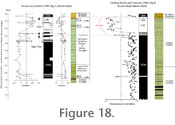 The sample-collection methodology of
Fassett and Steiner (1997) at Hunter Wash was different from that of
Lindsay et al. (1981) at the South Mesa, Barnum Brown Arroyo, Barrel Spring Arroyo, and Betonnie Tsosie Wash localities. The Fassett and Steiner samples consisted of oriented drill cores of the rock, whereas
Lindsay et al. (1981) carved out oriented blocks of rock for their samples. In addition, samples were processed differently in different labs on different instruments at different times. The samples for the
Fassett and Steiner (1997) Hunter Wash study were obtained at a locality 9 km west of the closest part of the
Lindsay et al. (1981) section (Figure 3,
Figure 4). In spite of these differences, the patterns of remanent magnetic polarity resulting from these independent studies are virtually identical.
Figure 18 shows a comparison of paleomagnetic data plots from
Fassett and Steiner (1997) and
Lindsay et al. (1981). (For ease of discussion, these sections are referred to as HW and HW/AW, respectively.) The sample-collection methodology of
Fassett and Steiner (1997) at Hunter Wash was different from that of
Lindsay et al. (1981) at the South Mesa, Barnum Brown Arroyo, Barrel Spring Arroyo, and Betonnie Tsosie Wash localities. The Fassett and Steiner samples consisted of oriented drill cores of the rock, whereas
Lindsay et al. (1981) carved out oriented blocks of rock for their samples. In addition, samples were processed differently in different labs on different instruments at different times. The samples for the
Fassett and Steiner (1997) Hunter Wash study were obtained at a locality 9 km west of the closest part of the
Lindsay et al. (1981) section (Figure 3,
Figure 4). In spite of these differences, the patterns of remanent magnetic polarity resulting from these independent studies are virtually identical.
Figure 18 shows a comparison of paleomagnetic data plots from
Fassett and Steiner (1997) and
Lindsay et al. (1981). (For ease of discussion, these sections are referred to as HW and HW/AW, respectively.)
Just above the top of C33n in the HW plot at 335 m (Figure 18), there is a thin normal interval and on the HW/AW plot a similar thin normal is present. Just below the top of the HW C33n normal chron, there is a thin reversed interval, and on the HW/AW plot at about the same level, there is a single-site polarity excursion that almost reaches reversed polarity. At the 370 m level there is the suggestion of a thin normal interval on the HW data plot; at exactly the same level on the HW/AW data plot, two data points represent an excursion toward normal polarity.
Gradstein et al. (2004) showed a thin normal interval above C33n labeled C32r.1n with a duration of 0.087 m.y.; this chron is separated from the top of C33n by a reversed-polarity interval (C32r.2r) of 0.239 m.y. duration. It is possible, therefore, that the thin normal interval at 370 m on the HW plot is chron C32r.1N. On both the HW and HW/AW paleomagnetic plots, thin reversed polarity intervals are present within chron C33n at the 188-195 m interval on the HW plot. Within this interval there are two thin reversals on the HW plot and only one on the HW/AW plot; this difference could be an artifact of the more closely spaced samples collected at the HW locality.
Gradstein et al. (2004) did not show this reversed interval in magnetochron C33n, probably because the much slower rates of crustal formation at the mid-Atlantic ridge did not allow this thin reversal to be recognized.
There has been reluctance on the part of some paleomagnetists to fully embrace the potential of paleomagnetic studies of sedimentary rocks because of the possibility of overprinting of hematitic minerals incorporated within those strata, but the close agreement in the results of the two independent paleomagnetic studies discussed above demonstrates that such strata did accurately record and preserve the remanent magnetic polarity of the earth's magnetic field at the time those rocks were deposited.
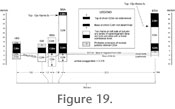 Because the Ojo Alamo Sandstone was deposited on an erosion surface, using the base of the Ojo Alamo as a horizontal datum (Figure 17) is misleading for comparing thicknesses of the Ojo Alamo normal intervals at the five localities.
Figure 19 reconfigures the upper part of this cross section using the base of the Ojo Alamo normal interval—a time horizon—as a datum. The boundaries of the Ojo Alamo normal interval are adjusted on
Figure 19, to the extent reasonably possible, to make these intervals as close as possible to the same thickness at each locality, while still honoring the sample-polarity data. In addition, the SM and BTW normal intervals are extended to match the tops and bases of the adjacent normal intervals. The results of this interpretation show that the Ojo Alamo Sandstone normal-polarity interval is about 11 m thick at all localities, and the maximum relief on the pre-Ojo Alamo erosion surface is about 4 m. These thicknesses are reasonable because the rates of sediment accumulation across this relatively small area were probably uniform, thus the thickness of the Ojo Alamo normal at these localities should be nearly the same. Because the Ojo Alamo Sandstone was deposited on an erosion surface, using the base of the Ojo Alamo as a horizontal datum (Figure 17) is misleading for comparing thicknesses of the Ojo Alamo normal intervals at the five localities.
Figure 19 reconfigures the upper part of this cross section using the base of the Ojo Alamo normal interval—a time horizon—as a datum. The boundaries of the Ojo Alamo normal interval are adjusted on
Figure 19, to the extent reasonably possible, to make these intervals as close as possible to the same thickness at each locality, while still honoring the sample-polarity data. In addition, the SM and BTW normal intervals are extended to match the tops and bases of the adjacent normal intervals. The results of this interpretation show that the Ojo Alamo Sandstone normal-polarity interval is about 11 m thick at all localities, and the maximum relief on the pre-Ojo Alamo erosion surface is about 4 m. These thicknesses are reasonable because the rates of sediment accumulation across this relatively small area were probably uniform, thus the thickness of the Ojo Alamo normal at these localities should be nearly the same.
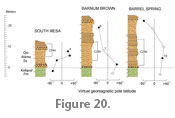 Figure 20 is a modification of figure 7 of
Butler and Lindsay (1985). These authors stated that: "Data from sites where evidence indicates normal polarity VRM [viscous remanent magnetism] overprinting are indicated with lines through the data points." but they are unclear as to why these particular sites were considered to be overprinted. Note that the Barrel Spring and South Mesa localities are shown (Figure 20) to contain two "overprinted" normal sites, and the Barnum Brown section has one "overprinted" normal site.
Butler and Lindsay (1985) (p. 543) stated that one of the features "crucial" to their interpretation was that "these reversed polarity sites occur throughout the stratigraphic interval from which + [C29n] was originally defined.. Figure 20 is a modification of figure 7 of
Butler and Lindsay (1985). These authors stated that: "Data from sites where evidence indicates normal polarity VRM [viscous remanent magnetism] overprinting are indicated with lines through the data points." but they are unclear as to why these particular sites were considered to be overprinted. Note that the Barrel Spring and South Mesa localities are shown (Figure 20) to contain two "overprinted" normal sites, and the Barnum Brown section has one "overprinted" normal site.
Butler and Lindsay (1985) (p. 543) stated that one of the features "crucial" to their interpretation was that "these reversed polarity sites occur throughout the stratigraphic interval from which + [C29n] was originally defined..
This statement is puzzling because there is only one reversed-polarity site shown within their original C29n chron, and that site is at the Barnum Brown locality (Figure 20, site 7). The reversed-polarity site shown on this figure is at exactly the same level as a reversed-polarity site shown to be present at Barnum Brown by
Lindsay et al. (1981) on their figure 7 (Figure 5 of this report), and the significance of this reversed site at that locality was discounted in the
Lindsay et al. (1981) report. Therefore the "crucial" evidence purporting to disprove the presence of normal-polarity interval C29n in the lower part of the Ojo Alamo was not provided in
Butler and Lindsay (1985).
Butler and Lindsay (1985), in their reexamination of the paleomagnetic-normal interval in the Ojo Alamo Sandstone at South Mesa, Barnum Brown Amphitheater, and Barrel Spring Arroyo, concluded that their earlier determinations that this normal represented true remanent magnetism were in error. Instead, they stated that this normal interval represented a present-day, normal-field overprint that should be removed from their paleomagnetic sections in the southern San Juan Basin. They offered no mechanism for how present-day normal overprinting might have occurred at these three separate localities. Photographs of the Ojo Alamo Sandstone at these localities (Figure 6,
Figure 7, and
Figure 10) show that the exposures are all in barren badlands that are eroding at a relatively rapid rate. Because samples for paleomagnetic analysis by
Lindsay et al. (1981) and
Fassett and Steiner (1997) were collected from fresh bedrock, never more than 1 m below the surface, any present-day normal overprinting would have had to occur within the last thousand years or so, at most. Thus, there is no conceivable mechanism for such overprinting of a normal-polarity interval in the lower Ojo Alamo, with virtually identical thicknesses, at three topographically different and separate localities. Moreover, normal intervals at two localities are overlain and underlain by reversed-polarity sites making it extremely unlikely that an 11 m thick interval in the lower part of the Ojo Alamo could have been overprinted by the present-day normal magnetic field while the overlying and underlying rocks, also containing titanohematite, were not similarly overprinted. Thus, the
Butler and Lindsay (1985) contention that the Ojo Alamo normal interval at the three South Mesa localities is a present-day normal overprint is rejected.
Lindsay et al. (1981) also identified a paleomagnetic normal interval in the lower Ojo Alamo Sandstone at the Betonnie Tsosie Wash locality. The presence of this normal interval was not questioned in the
Butler and Lindsay (1985)
paper, thus it can only be concluded that these authors believed that the Ojo Alamo normal interval at this locality, at least, did represent true Paleocene remanent magnetism. All available evidence shows that the paleomagnetic-normal interval present within the Ojo Alamo Sandstone at the five localities discussed herein, must represent true Paleocene remanent magnetism. Thus, the presence of paleomagnetic normal interval C29n in the lower part of the Ojo Alamo Sandstone confirms its Paleocene age. In addition, because the base of magnetochron C29n has an age of 65.12 Ma (Gradstein et al. 2004) and because the base of this chron is near the base of the Ojo Alamo, the age of the base of the Ojo Alamo can be estimated to be about 65.2 Ma. These findings are further supported by paleomagnetic data obtained at Mesa Portales, as discussed below.
|





 Figure 9,
Figure 9, Figure 10
Figure 10

 Figure 13
Figure 13

 Figure 16
Figure 16


 Figure 20
Figure 20